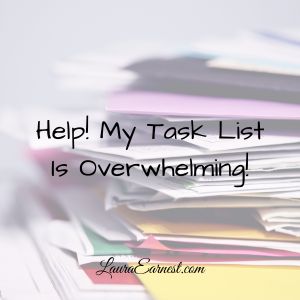“Help! My to-do list is overwhelming! It’s too long and I can’t get anything done!”
We’ve all been there. We have a task list that has more tasks than we can ever hope to get done today, this week or possibly even this month – and that’s without all the other stuff that comes at us each day.
Too Much To Do
The first thing you have to know when you are faced with an overwhelming task list, is that there is simply too much to do. Knowing that your task list has become an un-doable pile of work is the first step. The list has become the problem, and we have to pare it down.
Avoiding Overwhelm Paralysis
Personally, when I am faced with a list like that, I run away. Yep, I do nothing. And that makes the list worse the next time I come back to it.
So in order to maintain productivity, I have found that I have to trim and organize the list. This is how I do it.
MITs
Many systems recommend that you pick out 3 most-important-tasks (MITs) and do those. This is a good method in that it gives you something to focus on, and you know what you have to do. It takes us away from task list paralysis into the realm of doing, and that makes it more likely you will keep going.
The Downside of MITs
However, when your task list is truly gigantic, the MIT method isn’t sufficient.
Three tasks isn’t going to cut it when you have 50 waiting. Because we both know that more than three will be added to the list by tomorrow.
The other problem is that the MIT list focuses on the things that have the most value, and ignore the other things that might need to be dealt with first. You might be able to get away with ignoring laundry in favor of other tasks for a few days, but eventually you are going to run out of clothes to wear.
The last issue with MITs with a huge list is it is often hard to determine exactly what is the most important. You can no longer see the forest for the trees.
So with that being said, here is how to prune back a huge task list.
Method For Pruning A Huge List
There are two main steps to pruning a huge list: trim it back, then move stuff into other lists.
The “Should I Do This” Test
The first thing you need to do is to go through every task on your list, quickly, and answer the following questions:
- SHOULD I do this? This question focuses on whether or not the task even needs to be done at all. If not, remove it from the list.
- Should I do this? This question addresses whether or not you are the best person for the job. If not, make a note who is, and take it off your list.
- Should I DO this? Is this something that requires action? Sometimes things work out best if we do nothing. If this doesn’t require action, remove it from the list.
- Should I do THIS? Sometimes the wrong tasks end up on the list, and we hesitate because we know deep down it is not really what we need to do. If this isn’t the right task, make a note of what is, and remove this one from the list.
Now you have a pruned down list of tasks to accomplish. We need to sort them into areas so you know which ones are the first to be worked on.
Sort Them Into The Airport Parking Lots
When sorting tasks, I like to put them in parking lots, much as you would see at an airport.
- Curbside parking. Curbside parking at an airport is one where you pull up, quickly unload and leave. For tasks, it is the things you intend to complete quickly and move on. Like curbside parking at an airport, space is limited, and you should have no more than 5-6 tasks on this list.
- Short-term parking. Short-term parking is when you park to see someone off to the gate, or when you are waiting for someone to come in. It is meant to be used when you will be there more than 15 minutes. Consequently, there is more space, but if you park there very long, you will be hit with a hefty fee. For tasks, this should be the things that are moving up in the list, things that are coming due, or are important enough to queue for curbside. Its capacity should be no more than two to three times the curbside list simply from a do-ability standpoint.
- Weekly parking. If you drop your car at an airport at the beginning of a trip, it will go into a place known as weekly parking. Cheaper than the short-term parking, it is the place to go when you need to have to leave something for a while. For tasks, these are the things that you want to get to soon, or unfinished projects, that are not necessarily the most important at the time.
- Long-term parking. Some airports call this storage, but it is effectively when you are going to be gone a long while and you want to know your car will be there when you get back. It has the most capacity, usually being a lit field somewhere near the airport, and you have to take a tram to get there. For tasks, this can be called a “someday-maybe” list, and it is meant to hold things you might like to do someday.
When you have sorted your lists, you know what you need to do. Clear out curbside, then move a batch from short-term to curbside. Each time you plan, position tasks in each parking lot, clearing out the curbside, then short-term, then whatever long-term you can get done.
In conclusion, while it can be daunting when your task list becomes overwhelming, there are practical strategies you can use to regain control. By asking yourself key questions about each task, and sorting them into different ‘parking lots’ based on urgency and importance, you can prioritize effectively and keep your productivity on track.






